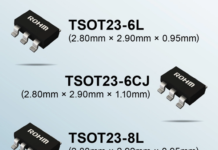
GAIA Converter is expanding its range of high reliability and industrial grade wide-input DC-DC Converters for Rail Applications to meet the needs of rapidly-evolving railway infrastructure. The upgraded ultra-wide input portfolio achieves outstanding mean time between failures (MTBF) performance while satisfying the most demanding surge requirements, allowing a near seamless modular architecture offering from 5W to 500W. GAIA Converter’s latest additions include an input bus conditioner, a new device that can suppress extreme surges in railway environments and board-mount parts rated at 20W, 40W and 80W, with the added feature of 3kVAC reinforced safety isolation rating to IEC 62368-1.
Railways worldwide are expanding and evolving to reduce emissions while optimizing safety, capacity, and interoperability. The widespread adoption of smart signalling and speed control systems like the European Rail Traffic Management System (ERTMS) is setting new, more stringent requirements for power conversion devices.
GAIA Converter’s new ultra-wide input range for each part is 12 -160VDC, to include 24V, 48V, 72V, 96V and 110VDC nominals to meet EN 50155 and other rail specifications, as well as standards for common industrial applications. The input will also withstand 176VDC for 100ms to include the surge specified in rail standard NF-F 01-510 for 110VDC nominal, as well as the RIA12 specification of 168VDC for 20ms for 48VDC nominal. Surges to 385VDC for 20ms to specification RIA12 can be met with the additional input bus conditioner type FLHGI90, which also attenuates fast transients, provides reverse polarity protection and ensures compliance with EN 550121 EMC specification. Without the input bus conditioner, the parts can meet EN 55022 Class B EMI with a recommended external filter. Outputs available for each model are 2 x 5V, 2 x 12V or 2 x 15V, which are mutually isolated and can be paralleled for higher current, placed in series for higher voltages or connected as +/- bipolar outputs for maximum flexibility. Efficiency is typically 87% and case operating temperature range is from -40°C to +105°C without derating. Output power derates by just 25% for input voltages lower than 36VDC.
Control functions include an on/off pin and output trim which can vary the outputs -20% to +10%. Protection features included are over-load, short-circuit, soft-start and input under-voltage lock-out, with a trimmable threshold, to match all battery voltage standards.
Each converter is offered in a fully potted low-profile metallic case: 35mm x 30mm x 10mm for the 20W part, 46mm x 36mm x 10mm for the 40W part and 50mm x 44mm x 12.9mm for the 80W part.
GAIA Converter has leveraged its years of experience serving the high-reliability market to design and manufacture these parts to the highest specifications with simple and elegant conversion topologies. This is reflected in the excellent MTBF performance achieved, typically above 1000 khrs according to Mil HDBK 217F GB, 25°C, where the usual figure for competing products is nearer to 300 to 500khrs for the same standard conditions. GAIA Converter also has a policy of long-term commitment to products, to ensure that customers have no concerns about obsolescence.
Christian Jonglas of GAIA Converter comments: “These high reliability and power-dense converters build on our range of board-mount products for critical applications, where the extra-wide input and reinforced isolation are real advantages. They are ideal for rail applications and in industry, where a single part can be stocked for multiple input voltage nominals”.

















